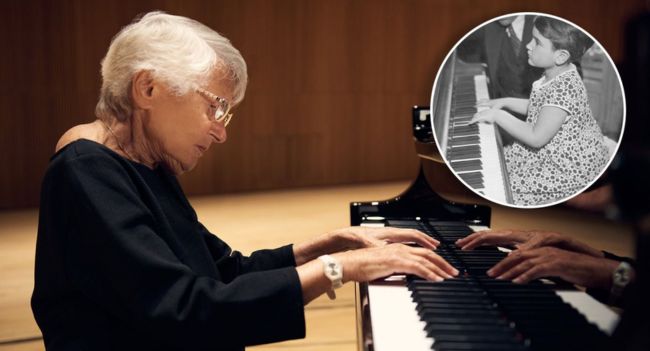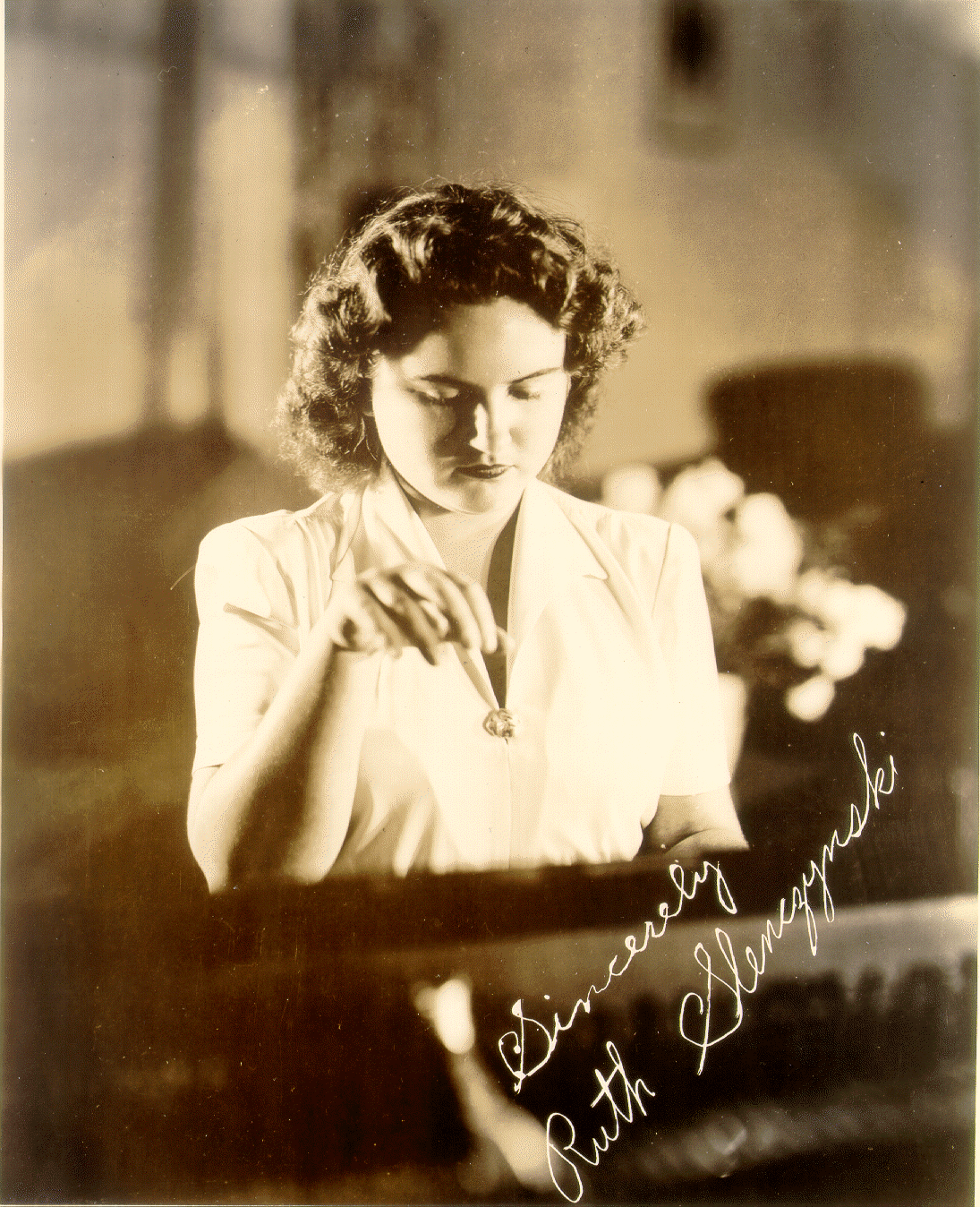Ruth Slenczynska: the pupil of Rachmaninov still releasing music at 97
Pianist who has played for five US presidents says great composer taught her to incorporate colour in music
The greatest lesson Ruth Slenczynska learned from the Russian composer Sergei Rachmaninov was that sounds have colour.
Nearly 90 years ago, the nine year-old Slenczynska was practising one of Rachmaninov’s preludes when he asked her to join him at the window. It was springtime in Paris, and the avenues were lined with mimosa trees laden with fluffy, golden blossoms.
“He said: ‘You see that? That’s what you want to bring to your sound – gold.’ I said: ‘Show me.’ So he sat down at the piano and put colour into his sound, he made it meaningful. And a little kid can copy anything,” she said.
Next month, Slenczynska, who has just celebrated her 97th birthday, will release her latest album after signing a global record deal. Born in California to Polish parents, the pianist gave her first recital at the age of four and was heralded as one of the greatest child prodigies since Mozart. She made her debut with a full orchestra in Paris at seven.

“Playing music is like taking a ride on a bus – you mustn’t let your passenger get off until he arrives at his destination,” she said. “Keep them interested in a beautiful way. I still try to do that.”
Each track of My Life in Music, released by Decca Classics, recalls a pianist or composer Slenczynska knew personally. Her friends and mentors have included a string of 20th-century classical music giants. Not only Rachmaninov – she is considered to be his last living pupil and often wears a Fabergé egg necklace he gave her – but also Artur Schnabel, Josef Hofmann, Egon Petri, Alfred Cortot and Samuel Barber.
She is quick to point out, however, that the life of a child prodigy was not easy. Slenczynska’s father, Joseph, a one-time head of the Warsaw Conservatory, was a tyrannical figure determined that she become a successful musician at any cost.
She remarked in her 1957 autobiography, Forbidden Childhood, about the emotional stress of having to practise nine hours a day without room for mistakes. “Nobody chooses to be a prodigy,” she said now. “I was pushed very strongly by my father, who thought it was a way to make money. Really, I was never a child.”
Slenczynska withdrew from performing when she was 15 and eventually cut off her father completely. She enrolled for a psychology degree and did not return to the concert stage until 1951. Since then, she has recorded 10 LPs for Decca Classics while holding a series of university teaching jobs.
She has played for Michelle Obama and five US presidents, including Herbert Hoover, John F Kennedy, Jimmy Carter and Ronald Reagan, as well as performing a four-hand duet with Harry Truman.
Slenczynska was in Washington for a concert when she received a mysterious phone call asking if she could alter her plans. The next morning, she was picked up “by a gorgeous car” and driven – to her surprise – to the White House.
“We got to a great big double door, with a marine on each side. I walked in and there was Mr Truman, president of the United States. He shook my hand and said: ‘Would you like to play the duet with me?’”
The president, it transpired, had been practising a Mozart sonata and wanted to play with the best. “We sat down on the bench together and it went very well. He played very musically and attractively. Afterwards everyone applauded. Then I was pulled away and I said: ‘I didn’t even get a picture!’”
Years later, after a concert in Kansas City, she had an unexpected visitor. “It was a nasty, cold evening with sleet coming down. I was changing backstage, when there was a knock at the door. I thought it was the lady who brought me. I opened the door and Mr Truman came in. ‘You played four hands with me once, remember?’ he said. And we had the most marvellous chat.”
For all the huge changes she has lived through since her childhood debut, Slenczynska’s commitment to the art of music and performance has remained steadfast. During the first Covid-19 lockdown in 2020, she uploaded home recordings of Beethoven’s sonatas to YouTube to celebrate his 250th birthday. Her next recital, to mark her own, takes place in Pennsylvania on 6 February.
Her age, she says, has “kind of crept up on” her. “All at once you look back and say: ‘Oh, my goodness, that happened 50 years ago.’ I still keep on my dresser a picture of my lovely husband. And every once in a while, it dawns on me – he died in 2000. But I’d marry him again if I could, he’s still my sweetheart.”
Does she have any regrets? “No,” she says, “looking back doesn’t do any good. Look forward, and make that as beautiful as you can.”

The story of Ruth Slenczynska tells us an incredible amount about music. In 1925, Ruth Slenczynska was born in Sacramento, USA to two Polish parents. Slenczynska began as a child prodigy who performed her first piano recital at the age of 4, and some have even gone on to say that she is one of the greatest since Mozart. At just 5 years old, Slenczynska played a Beethoven piece that featured on television.
Slenczynska is the last living pupil of Russian conductor, composer and pianist Sergei Rachmaninoff. When Rachmaninoff was unable to perform on his tour due to illness, Slenczynska stepped in and played beautifully for the crowds, and they were not left disappointed.
Since then, Slenczynska has performed around the world, touring at some of the most reputable venues and has played for the likes of President Kennedy, Reagan and Carter, Michelle Obama, as well as playing duets with President Truman.
Her career has lasted for a massive 9 decades, but this star’s musical journey is not over. At the age of 97, Slenczynska has scored herself a global record deal with Decca Classics.
Despite formerly producing 10 albums with Decca records throughout her career, Slenczynska has not produced anything new for the past 60 years. During the Covid-19 lockdowns, Slenczynska ensured that she did not lose touch with her musical abilities or those who support her by posting videos of her playing the piano on YouTube.
Her newest album, My Life in Music, will be released later on in the year and will reflect her incredible journey and life experiences through the medium of music.
Rachmaninoff not only taught her how to play the piano incredibly, but he demonstrated how music can impact on greater life. Ruth says, ‘When I play a piece of music, I like to have it say something. A piece of music that doesn’t speak isn’t…it isn’t there. If I’m not speaking to my audience, they’re wasting their time and I’m certainly wasting my time. ’
In the end, music is more than just notes on a sheet of paper or sounds on a keyboard, but it tells a story and inspires us in ways we had never imagined possible. If you want to see more from Ruth go grab her latest album called “My Life in Music” and take a listen to her wonderful talents.
Ruth Slenczynska Biography

Ruth Slenczynska, American pianist; b.Sacramento, Calif, Jan. 15, 1925. Her father, Joseph Slenczynski, a violinist, imposed a rigorous and disciplinary practice routine on her beginning at age three. She began her piano studies in Europe at age four and took lessons with Arthur Schanabel, Egon Petri, Alfred Cortot, Joseph Hofmann, and even performed for Sergei Rachmaninoff. She performed her debut in Berlin at age six, and made her debut in Paris with a full orchestra at age eleven. She became an instant musical sensation in Europe, heralded as the first child prodigy since Mozart. However, the strain of practice and the touring schedule imposed upon her by her father caused great emotional stress upon her, and by the age of fifteen she withdrew from performing. Ms.Slenczynska applied and was accepted to the University of California where she met fellow student George Born.The two eloped after a short engagement in 1944 and remained married until 1953 when the marriage ended in divorce. In 1954 the artist resumed her concert career and established herself as a pianist of impeccable technique and considerable musical insight. In 1964 she accepted a full time position at Southern Illinois University at Edwardsville as Artist- in-Residence, a title she retained until 1987.Ms.Slenczynska married in 1967 to Dr.James Kerr, a professor of political science at SIUE. She published a book of memoirs, Forbidden Childhood(N.Y., 1957), which deals with life as a child prodigy, and a book on piano technique, Music at Your Fingertips: Aspects of Pianoforte Technique(N.Y., 1961). |

